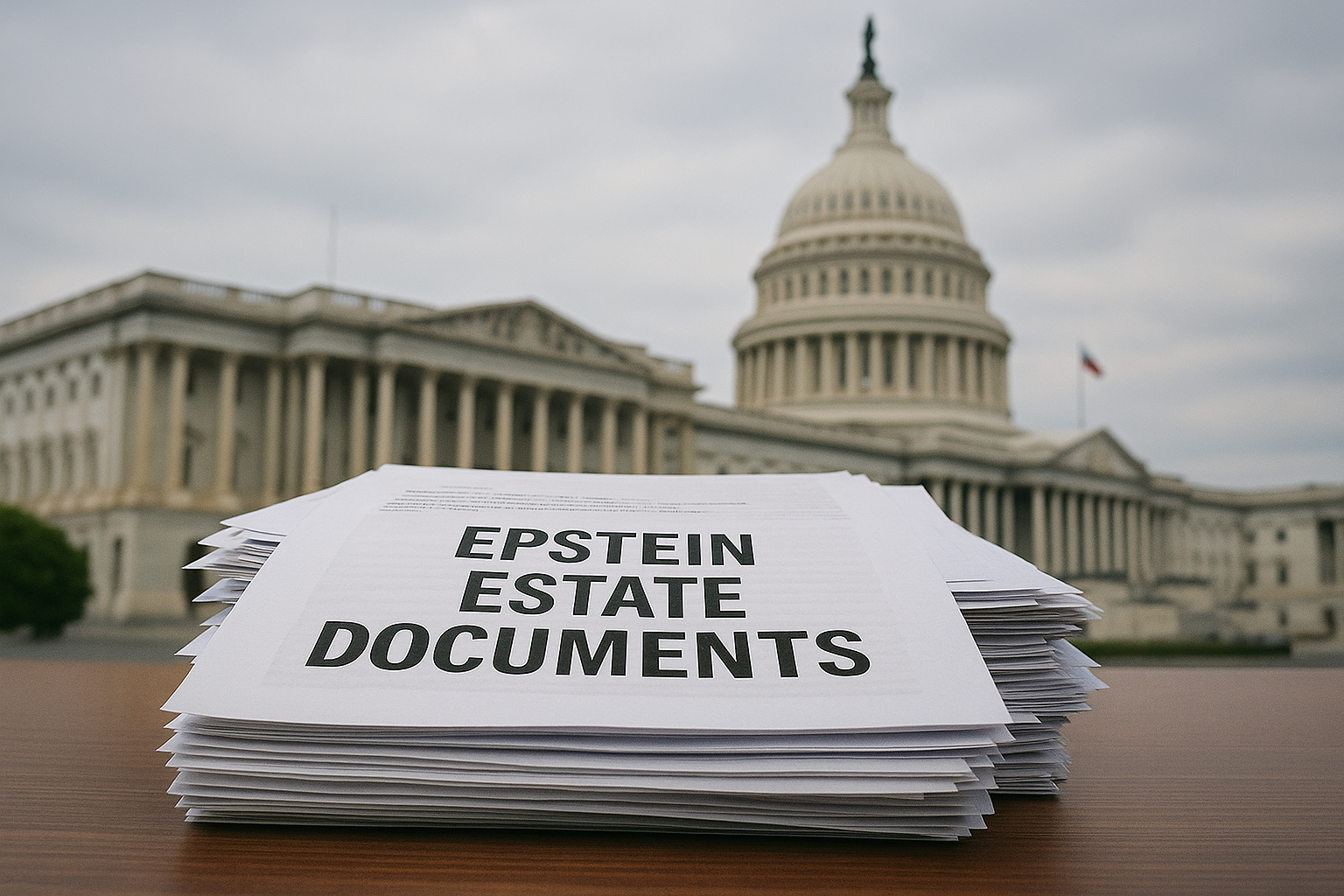Epstein emails Trump — those three words are driving today’s political conversation after House Democrats publicized a handful of messages from Jeffrey Epstein’s estate while Republicans on the same committee followed with a far larger tranche. The new materials include a 2011 email suggesting Donald Trump “spent hours” with a victim at Epstein’s residence and a 2019 message claiming Trump “knew about the girls,” alongside separate exchanges with author Michael Wolff. The releases sparked an immediate clash: Democrats argue the emails raise fresh questions; the White House calls the rollout a partisan smear and points to past statements by Virginia Giuffre asserting Trump did not engage in wrongdoing. AP News+2ABC News+2

What was actually released—and by whom?
According to statements and contemporaneous reports, Democrats on the House Oversight Committee disclosed three email exchanges obtained from Epstein’s estate. Shortly afterward, Republicans on the committee released a much larger body of material—tens of thousands of pages—framing the Democratic move as cherry-picking. Both releases are part of a broader tussle over whether to compel a full airing of remaining Epstein-related files. The Washington Post+1
The volume of documents is non-trivial: the estate produced roughly 23,000 pages (around 2,900 documents), delivered under subpoena. That number is now central to competing narratives—one side highlighting a few items it says are newsworthy, the other insisting that a fuller context is necessary. AP News
The headline allegation inside the cache
One April 2011 email from Epstein to his longtime associate Ghislaine Maxwell asserts that the “dog that hasn’t barked is Trump,” adding that a named victim “spent hours at my house with him.” In some versions circulated publicly, the victim’s name appeared redacted; other versions reportedly contained the name unredacted in the larger committee file sets. Regardless of versions, the core allegation is Epstein’s assertion—written in his own words—of proximity between Trump and a victim. It is an allegation, not a criminal finding, and stands in tension with denials from Trump and statements that the White House highlights. AP News+1
The 2019 email: “knew about the girls” claim, and why it matters
A separate email dated January 2019, written by Epstein and addressed to journalist Michael Wolff, claims Trump “knew about the girls” and had asked Maxwell to “stop.” This is explosive language, but again, it is a single person’s claim in correspondence—not sworn testimony, not a conviction, and not independently corroborated in the same release. It nonetheless becomes politically potent because it intersects with long-running questions about who knew what about Epstein’s conduct and when. AP News+1
How “Epstein emails Trump” became a political flashpoint
“Epstein emails Trump” didn’t trend by accident. The phrase captures two overlapping news streams: congressional document releases and presidential politics. Democrats describe the emails as striking a blow against an alleged cover-up; the White House characterizes the release as selective leaking designed to smear the president. Republicans on the committee, for their part, responded by opening the floodgates on a far larger trove—positioning themselves as opponents of cherry-picked narratives. Oversight Dems+1

What the White House says, and why the Virginia Giuffre factor looms large
Within hours, the White House asserted that the “unnamed victim” referenced in the correspondence is Virginia Giuffre. Officials argue that Giuffre repeatedly stated Trump was not involved in wrongdoing and was cordial in limited interactions—citing prior public comments and a memoir published posthumously. The White House frames this as proof that the emails, as publicized by Democrats, create a “fake” or misleading narrative. The Washington Post+2AP News+2
It’s important journalism-wise to parse this carefully. Giuffre’s accounts have loomed over many Epstein-related stories involving high-profile figures. In relation to Trump, her past statements—highlighted by the White House—cut against inferences that the 2011 email might otherwise invite. That tension between a victim’s own on-the-record statements and an abuser’s private claims is a major reason today’s headlines are as contested as they are. AP News
Michael Wolff’s role in the newly public messages
The email trove includes exchanges between Epstein and author Michael Wolff. In one 2015 thread, Wolff appears to anticipate CNN asking Trump about his Epstein ties and suggests a media-strategy frame: let Trump “hang himself” or create leverage depending on what he says. In October 2016, days before the presidential election, Wolff floated an interview that could “finish” Trump—again underscoring that Epstein believed his knowledge of Trump had PR currency. Wolff has previously acknowledged speaking to Epstein while writing about Trump. ABC News
What we know—and what we don’t
What we know:
• The documents are real committee materials produced by Epstein’s estate under subpoena.
• The specific 2011 and 2019 emails exist and are quoted in multiple respected news outlets and committee statements.
• The White House says the referenced “victim” is Virginia Giuffre and points to her prior statements downplaying any Trump misconduct.
• No new criminal allegations against Trump have been filed alongside these releases; Trump continues to deny wrongdoing and has long claimed he distanced himself from Epstein years before Epstein’s first arrest. AP News+2Oversight Dems+2
What we don’t:
• Independent corroboration of the 2011 “spent hours” claim beyond Epstein’s own email wording.
• Documentary backing for the 2019 “knew about the girls” assertion beyond Epstein’s message to Wolff.
• A complete, contextualized picture of the larger 20,000-plus pages—only a fraction has been surfaced in media coverage so far. The Washington Post
Why “Epstein emails Trump” is resonating now (and not six months ago)
Timing is politics. The House just returned to Washington amid shutdown brinkmanship, and the Oversight Committee has been a central venue for Epstein-related subpoenas. Democrats seized the morning narrative with a small, potent selection; Republicans countered with volume. That sequencing guarantees a multi-day story cycle, not least because reporters, researchers, and political actors will continue combing through the larger files for new angles, confirmations, or contradictions. Al Jazeera
The legal-journalism tightrope: wording, attribution, and standards
Responsible coverage here hinges on precise verbs and clear attribution. “Epstein alleges” is materially different from “Trump did.” In this piece, all specific claims originate in (1) the emails attributed to Epstein and (2) official or on-the-record responses from the White House, committee members, or outlets that reviewed the materials. That’s why you’ll see formulations like “the email states,” “the White House says,” and “Democrats argue.” They’re not just stylistic—these cues are essential to accuracy and fairness. AP News+1
Context on the principals, kept tight and relevant
Jeffrey Epstein died by suicide in 2019 while awaiting trial on federal sex-trafficking charges. His accomplice, Ghislaine Maxwell, is serving a 20-year sentence following her 2021 conviction. Trump, who had a social acquaintance with Epstein in the 1990s and early 2000s, has repeatedly said he distanced himself from Epstein long before legal troubles escalated and that he barred Epstein from Mar-a-Lago. None of today’s document releases change the legal posture: there are no new charges or filings naming Trump in criminal conduct. AP News

“Epstein emails Trump”—inside the 2011 message
The April 2, 2011 note is striking because it uses the “dog that hasn’t barked” metaphor. Epstein frames Trump’s public silence as a tactical absence and underscores that a victim spent extended time with Trump at Epstein’s home. Even if one grants that Epstein routinely boasted or manipulated narratives, the email still functions as evidence of what Epstein believed—about Trump’s exposures and leverage—at that time. That’s the probative value: not courtroom proof, but a contemporaneous window into Epstein’s mindset and strategy. The Washington Post+1
How Republicans reframed the story with a document deluge
In releasing roughly 20,000 pages soon after the Democratic disclosure, Republican committee members attempted to shift journalistic baselines from “a few explosive emails” to “the full record.” It’s a classic counter-programming tactic: emphasize completeness, accuse opponents of cherry-picking, and suggest that context will neutralize splashy excerpts. Reporters will now look for whether broader context clarifies, contradicts, or leaves untouched the narrower Democratic highlights. The Washington Post
The White House’s communications posture
From identifying the “unnamed victim” as Giuffre to citing her prior statements and memoir, the White House adopted a proactive stance instead of a “no comment.” That approach signals confidence in rebuttal materials and a desire to keep the focus on documented, on-the-record remarks by a central accuser rather than on Epstein’s private assertions. Expect continued emphasis on three talking points: (1) selective leaks, (2) Giuffre’s past statements, (3) Trump’s longstanding denials and claims he expelled Epstein from Mar-a-Lago. The Washington Post+1
Subheading with focus keyword: What the “Epstein emails Trump” saga doesn’t prove
Important: the presence of an allegation in an email does not, by itself, establish the underlying fact. That’s Journalism 101. The 2011 and 2019 emails are relevant, newsworthy, and potentially illuminating, but they are still assertions by Epstein. To convert those assertions into established fact would require independent corroboration—contemporaneous records, third-party testimony, travel logs, security footage, sworn statements, or other documentary evidence. As of now, none of the outlets reporting on these emails have presented such corroboration specific to the “spent hours” or “knew about the girls” claims. AP News
Media-strategy correspondence with Michael Wolff: why it matters less legally, more politically
The Wolff threads are instructive not because they prove wrongdoing, but because they illuminate how Epstein thought about political leverage during key campaign moments. The notion that Epstein saw potential upside in either “hanging” Trump on a contradiction or “saving” him to accrue debt is classic power-broker thinking. It also maps to a broader pattern documented by reporters: Epstein cultivated relationships across media, tech, academia, finance, and politics, often trading in information, proximity, and favors. ABC News
What happens next: process and politics
• Document digestion: Journalists, watchdogs, and partisans will mine the 20,000-plus pages for context, contradictions, or corroboration.
• Oversight dynamics: The committee may face renewed pressure—possibly a discharge petition or a straight-up vote—to force broader disclosure of Epstein-related records held by other agencies, including DOJ.
• Narrative jousting: Expect iterative releases, selective highlights, and dueling press conferences as each side tries to define what the emails “mean.” The Washington Post

How to read today’s stories like an analyst (and not a partisan)
- Separate claims from proof. Allegation ≠ evidence ≠ charge ≠ conviction.
- Track provenance. Who released which doc, and what else did they have that they didn’t show?
- Use contemporaneous anchors. Emails are time-stamped artifacts—interpret them within their date context and any known events around those dates (debates, media appearances, legal filings).
- Beware narrative stitching. If an outlet welds together far-flung fragments to make a clean story arc, ask what links are speculative. PBS
Subheading with focus keyword: “Epstein emails Trump” and the role of Virginia Giuffre’s prior statements
The White House’s counter revolves around Giuffre’s public record. Outlets have reported that Giuffre—whose memoir was released posthumously—did not accuse Trump of misconduct and described him as cordial in limited interactions. If accurate, that creates a narrative brake on the inference that the 2011 email might otherwise drive. It doesn’t erase the allegation in the email, but it complicates it—and responsible reporting must include both. The Washington Post+1
A brief ethical note on naming and redactions
Democrats said they would not publicly identify victims; some committee files or media reproductions apparently surfaced with fewer redactions, revealing names in at least one instance. Newsrooms will make their own calls on whether to print those names given prior public prominence. Ethically, the presumption should favor minimization unless there is compelling public interest that outweighs privacy and safety concerns, particularly for victims or their families. The Washington Post
Bottom line
Today’s releases make news because they add primary-source texture to a long-running, intensely scrutinized relationship between a convicted sex offender and a sitting president. They do not, on their face, establish criminal wrongdoing by Trump. They do, however, raise questions that only fuller context—or genuinely independent corroboration—can resolve. In the meantime, “Epstein emails Trump” will continue to dominate the political conversation, precisely because it sits at the intersection of documentation, allegation, and narrative combat. AP News
— — —
External sources (for reference):
• Washington Post: “House Democrats release Epstein email that claimed Trump ‘spent hours’ with victim.” The Washington Post
• AP / PBS: “Epstein email says Trump ‘knew about the girls’…” (and White House briefing live). AP News+1
• ABC News: “House Democrats release new Epstein emails referencing Trump.” ABC News
• House Oversight Democrats: Press release on newly released emails. Oversight Dems
• CBS News: Coverage referencing Giuffre’s posthumous memoir and prior statements. CBS News


